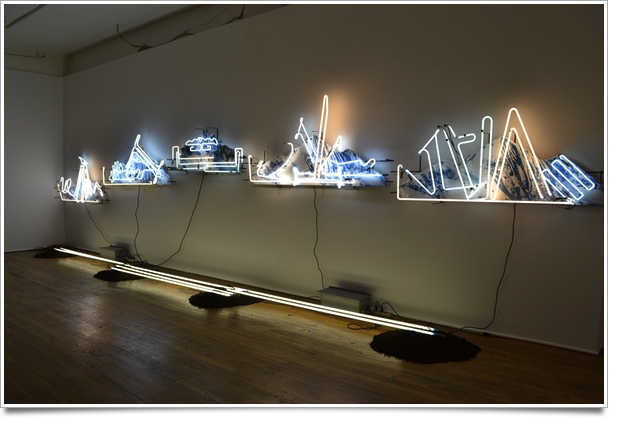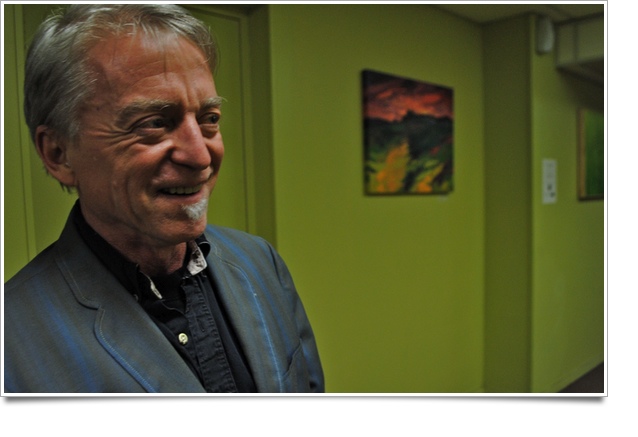Fri 2/15 @ 5PM
Cleveland-based neon artist Jeff Chiplis is debunking the old adage “lightning never strikes the same place twice.” A decade ago, some art-world buzz around his work constructed from repurposed found neon netted him a show at New York City’s White Box Gallery.
He did not instantly become the next big art star. He continued to work in Cleveland, show his work and sell his creative light pieces to both art collectors and businesses looking for out-of-the-ordinary signage.
Chiplis recently completed his largest and most ambitious work yet, “The Great White Mountains and the Cold Cathode Plains.” Stretching 28 feet, it’s currently on display at the William Busta Gallery, which will host an exhibition reception from 5-9 pm tonight. But after March 2, Chiplis will be packing it up and taking it to New York for the Scope Art Fair March 6-10, where he’ll expand it to a panoramic 60 feet.
There he’ll add two segments to the five-segment piece, which features photos of snow-capped mountains, their contours selectively heightened by the cold, glowing blues and whites of the layer of neon tubing fronting them. Piles of earth on the floor underneath the wall-installed segments support more white neon tubing. It’s a formidable, poetic work, contrasting darkness and light, flatness and dimensionality, the monumental size of the real mountains with the scaled-down size of the armatures, the actual earth on the floor of the gallery with the reproduction of earth in the photos.
On the other hand, Chiplis says he overheard Busta tell somebody it’s about skiing. Take that, art jargon!
Chiplis says he’d been thinking about doing a larger piece for a while. He was encouraged to produce it by after Bill Busta visited his studio last fall.
“It’s always fun to think about doing big projects but it did come up in that the material became available — these armatures,” says Chiplis.
Because Chiplis builds his work from recycled materials, much of his inspiration comes from the material itself. The photos came from armatures — frames that hold the neon sign — provided by a friend who does sign repair. They came from just where you might think — beer signs.
“When they come to him, they’re either fixable or they’re beyond repair or it’s not cost-effective to repair,” says Chiplis. “Once he determines it’s not worth, then they get retired. Ordinarily they would go into a dumpster somewhere, except I’m standing in front of the dumpster catching them, figuratively speaking.”
Chiplis removed the glass and the “branding stuff” and built the pieces by layering on white glass he already had.
The dazzling, frigid piece is an eye-grabber, creating an environment and an atmosphere in the room the way none of Chiplis’ other admittedly striking pieces have.
“I knew when I was working on it that it was going to be a big deal,” he says.
How big a deal remains to be seen. A veteran artist like Chiplis knows that so much of being recognized in the art world is a matter of luck, timing, and accident. His first New York show was featured in the March 2003 issue of defunct Cleveland arts magazine Angle, along with painter Dana Schutz, a 2001 Cleveland Institute of Art graduate then just starting to get know. Her career has skyrocketed, while Chiplis’ has just chugged onward.
In the case of the Scope Art Fair, it just happened that someone who knew his work was one of the organizers. She asked him if he could produce a 60-foot piece for the entrance of the fair. He was already working on the piece for the Busta show.
“Luckily there were two more of the armatures I could use to make it that much bigger,” he says.
Chiplis began working with neon when he came to Cleveland three decades ago. He laughs that he was doing “upcycling” — a term he pokes genial fun at — long before it became trendy in the arts world.
“In my wandering around I saw there was this material out there that was not being used, so I got my first piece of glass,” he says. “Now I don’t have to purloin it anymore, it finds its way to me. Sometimes I come home and there are things waiting on my doorstep. It’s all recycled. Well, I used to say recycled, but now it’s ‘green’ everything.”
Whether his work will become trendy among “important” collectors remains to be seen. Chiplis is sanguine about it.
“A lot of people will buy paintings, photographs, prints, whatever,” he says. “When they get tired of them they put them in a closet somewhere. My work doesn’t lend itself to being put away in a closet. I like to think when people buy my work, they are more committed.”
http://williambustagallery.com
Cleveland, OH 44115


